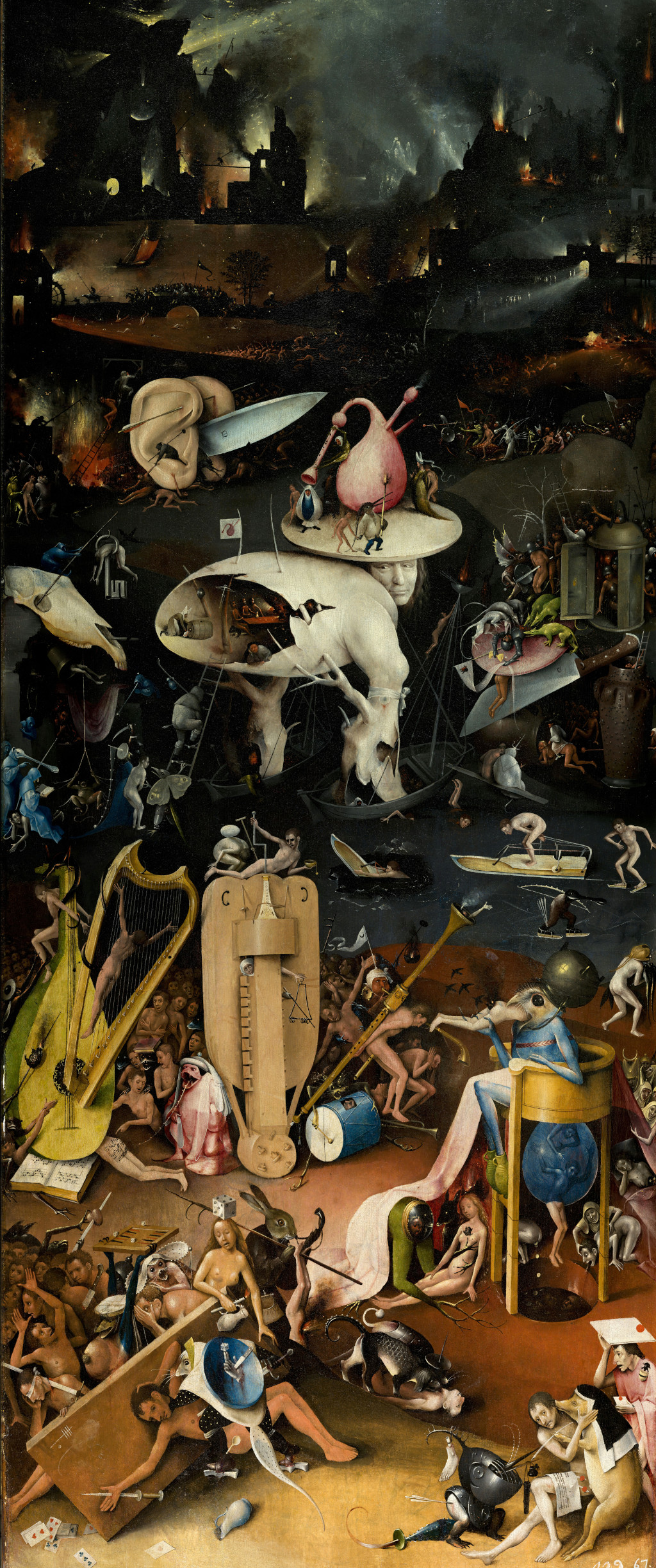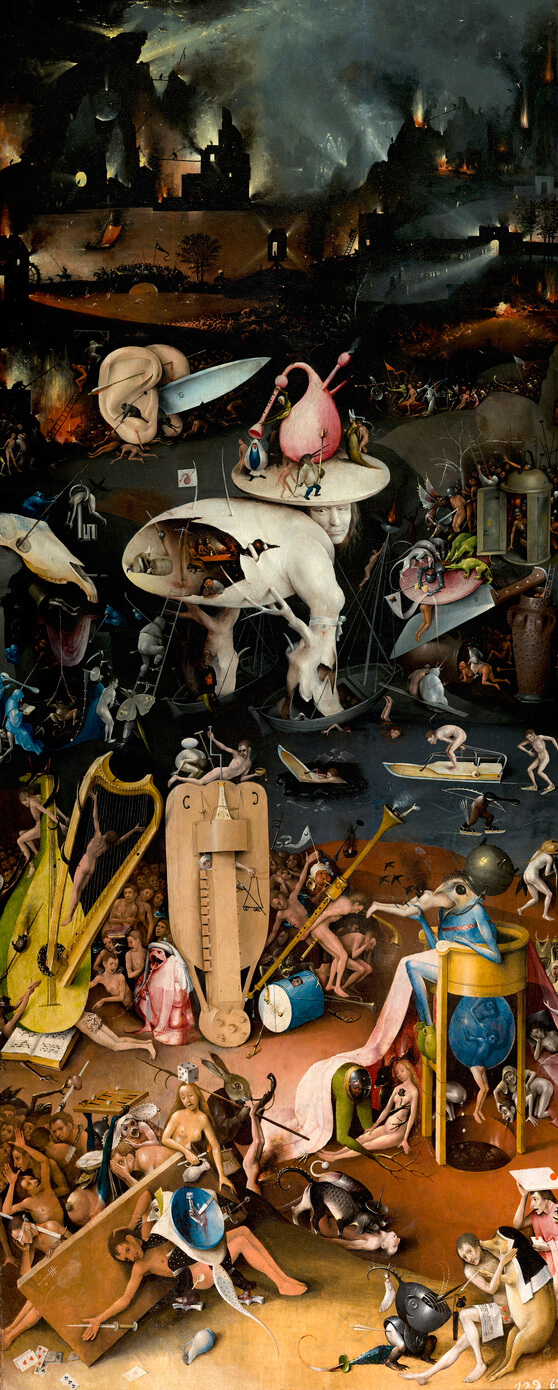Hieronymous Bosch's vision of Hell is found on the right hand panel from his immense triptych, The Garden of Earthly Delights, painted between 1490 and 1510 (most likely 1495-1505).
Introduction
Hieronymus Bosch made use of the emotive theme of Hell within several artworks. The iteration featured here was from the right hand panel of his epic, The Garden of Earthly Delights. Here we examine the many detailed features of this piece and place it within the overall series of four artworks which made up this multi-sides triptych. The very nature of Hell was ideally suited to the work of Hieronymus Bosch, an artist, after all, who revelled in the darkness of life and who also regularly used biblical content within his paintings. Bosch was an artist all about expression and imagination, and he would re-invent many topics from the Bible that had already been used on countless occasions by other artists. Whilst the likes of Van Eyck would focus on technical precision, Bosch took existing themes and appended his own extraordinary imagination on top. His panel titled, Hell, is a perfect example of this. For the benefit of those unable to see this majestic piece in person at the Prado Museum in Madrid, we have included some large images of various details in the composition below.
Garden of Earthly Delights Triptych
The Garden of Earthly Delights triptych as a whole shows a narrative sequence that starts on the left with Paradise and the Creation of Eve, continues in the centre with Mankind before the Flood, and ends up on the right in Hell. On the opposing, external shutters, the actual story begins with Creation of the World up to the Third Day. Man starts in Paradise, falls because of Eve's disobedience when she eats the apple, and ends up condemned to eternal damnation in retribution for his sins. Bosch's Hell is a more richly realised and individual Hell than the normal medieval underworld. It's a world of weirdness. In the background, cities burn; the scene is cold, with a blueish tinge to many of the colours, and it's full of intense detail, and very strange detail at that. Bosch's nightmare vision is like Breughel on steroids - the same feeling of a world full of people all busy pursuing their own activities, and full of precisely observed everyday objects, but in Bosch's world, everything has been strangely transformed into the stuff of nightmares.
Description
There's a knife which has ears, self-playing pink bagpipes, and a big pair of buttocks being used as a hymn book by the choir. As this is Hell, people are being tortured, but Bosch invents new ways of processing human flesh. A bird-headed demon in a high chair swallows and excretes human bodies, a parody of God creating man. There are people being impaled, one on an oboe - musical references are everywhere in this painting, from the bagpipes to a big hurdy-gurdy, as if hell is made up of noise. Perhaps Bosch thought music was one of the biggest temptations to sin, or perhaps he just didn't like it. At the centre of the painting is perhaps its greatest oddity, a hollow man whose body is made out of, but is also pierced by, a strange tree. Some art historians think the face, turned towards the viewer, is a self-portrait; that can't be proved, but the face seems to be questioning. Inside the man's eggshell-like broken body, three tiny figures are sitting at a dinner table.
Meaning
The meaning of this strange picture will continue to be debated as long as there are art historians, but its emotional power is undeniable. Bosch wanted to deliver art which could both teach and entertain at the same time. He desired a society with a strong moral backbone, and so hoped that his extravagant, somtimes brutal messages could lead people down the right path. Whilst much research has been completed on the triptych, as well as the Hell panel more specifically, most have concluded that Bosch's approach is fairly typical of the period in terms of his interpretation of the passages of the Bible. The unique element is the expressive artistic manner in which he delivers these scenes, unafraid to shock, even appal his audience. The overall story within the Hell panel is that humanity has succumbed to temptation and the result of this is the arrival of evil itself, and damnation. Bosch goes away from the warm, natural tones of the previous panels and focuses here on darkness, death and despair. Bosch leaves an assault on the eyes within this piece, delivering as much extreme negativity as he can, providing a strong warning against temptation and also contrasting this against the upbeat neighbouring panels.
Individual Details
Bosch depicts a burning city in the upper part of the Hell panel, and this would serve as one of the most memorable parts of the composition. He chooses to use relatively contemporary architecture, which immediately draws a connection to his childhood experience in which the Bosch family home would burn down. There rest of the scene is entirely unconnected to the modern world, though, as the artist creates an imaginary world built on pain, suffering and punishment. The creativity that he displays in achieving this is extraordinary, and it remains one of the finest examples of this theme within western art. There is then a plethora of nightmarish figures dotted around the rest of the work which combine elements from reality and the depths of Bosch's imaginaton. An owl-like creature features here, just as it does in each of the other panels, bringing a touch of consistency between the different artworks. The version in Hell is dressed in blue and symbolically sits atop a commode, whilst punished humans suffer around its feet. A contract rolls out which must be signed and marks the end of the human's rights.
There is also a tree-man that carries on from a number of the artist's drawings and is shown with a human face, looking back towards us, revealing its bizarre, open-shelled body. There is then some human ears with a knife protruding between them plus whole series of knives and arrows planted into other figures. Various activities are being carried out on ice in one part of the scene and some research has actually found further images lurking beneath the ice itself, having been worked over by Bosch during the development stage. Many more amendments have been uncovered, suggesting that despite his willingness to practice different creatures in pen and ink, he was still someone who liked to adjust an artwork right up to the last minute, directly on the panel itself. To see an artist take the original passages of the Bible and extract such a world of drama and horror displays unrivalled imagination and an incredible attention to detail.
Preparation
Hieronymus Bosch produced many drawings within his career, normally as studies for individual components of larger compositions. His imaginative creatures were not entirely spontaneous, but intead had been developed using pen and ink prior to the start of each painting. There are drawings of a tree man as well as studies of monsters which still exist today, and some of these may have been preparation for the various panels of the Garden of Earthly Delights. Sadly, most of his drawings would not have lasted the passage of time and may have been passed around his studio to guide his assistants, inevitably leading to damage or loss. Several pages uncovered from his career include many multiples of designs, one figure after another, which he would then later dismiss or incorporate into his larger pieces. He would make use of so much detail within some of these triptychs that solid preparation was essential, especially because many of these creatures from the depths of his mind were not based on anything in reality, and so their forms were entirely experimental.
Location
The Hell panel, as part of The Garden of Earthly Delights, has been on display at the Prado Museum in Madrid since the 1930s. A decree confirming its permanent loan from the Patrimonio Nacional was completed in 1943. It is currently housed within an exciting room which includes several other artworks by Bosch himself, and this section of the museum remains amongst the most visited, even though most of the museum is specialised in Spanish art for the local community. Engelbert II of Nassau initially owned the piece immediately after it was completed, before its ownership passed to Henry III of Nassau until around the middle of the 16th century. It would then be acquired by various North European dukes and noblemen until switching to Spain in the late 16th century. Philip II then transferred it to the Monastery of San Lorenzo de El Escorial who held on to it before allowing the public to access it during the 20th century at the Prado Museum.
Date
Hieronymus Bosch produced all five panels of The Garden of Earthly Delights between the years of 1490 and 1510. It is not known in which order he produced this series of panels, or how much assistance he received from his workshop. The wide ranging date attributed to the triptych places the artist at somewhere between forty and sixty years of age. The expectation is that the artist would have completed the whole project within a year or two, as this was the timeframe taken with some of his other triptychs.
Bosch's other Interpretations of Hell
Hieronymus Bosch produced another version of Hell which today resides at the Gallerie dell'Accademia in Venice, Italy. It too was a panel within a larger project, sitting alongside Ascent of the Blessed, Terrestrial Paradise and Fall of the Damned into Hell. This powerful scene features the same darkness and despair as the version featured in the Garden of Earthly Delights, but with a far reduced number of characters and detail. We find a flurry of humans being tortured in the lower half of the painting, desperately trying to stay afloat within the blood-toned water. Skeleton-liked creatures grab them and try to pull them under in this frightening depiction of demonic content. The lighting is dramatic here, with tones of yellow and orange showing from behind a tall rockface which casts a shadow over the figures below. A single tree sits limply to the left, symbolically devoid of life or hope. Although a respected piece, this Venetian version is not amongst the artist's best known works, though it is interesting to see how he addressed the theme of Hell in different ways within his career.
Large Image of the Hell Panel
Each panel within the triptych is just over two metres long and all of the interior panels are filled with extraordinary detail, with sprawling scenes which offer no beginning or end. Entertainment and a moral messages are delivered together in harmony and it is entirely necessary to provide a larger image of the Hell panel in order to really understand and appreciate the amount of work completed by Bosch for this project. It is his imagination, after all, which lied behind the success of The Garden of Earthly Delights, as the biblical passages covered here was nothing new to the art world. It is the individual creatures and characters found within this triptych that made this interpretation so breaktaking and memorable, and it remains one of the biggest attractions to the Prado Museum in Madrid. It is necessary to stand fairly close to the original artwork because of the amount of detail crammed into this display, and unfortunately it is not always possible to see the exterior panels because of how the item is shown currently within the museum.





